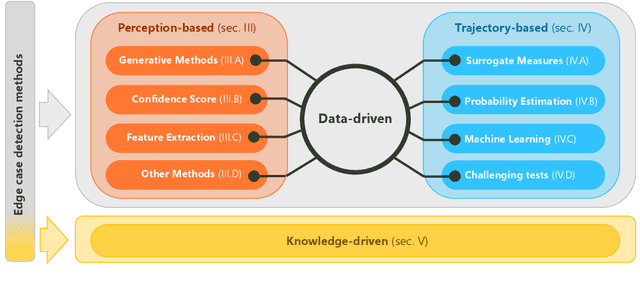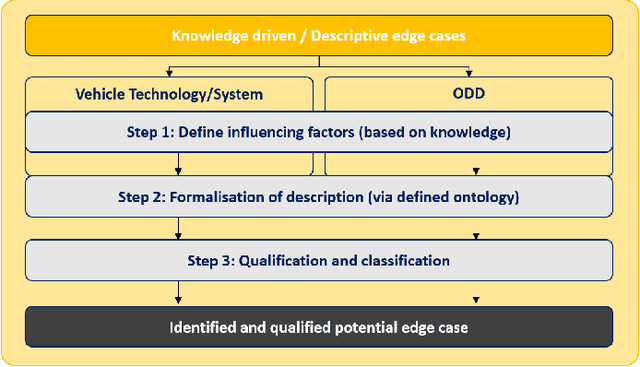Sabine Rieder
A Systematic Review of Edge Case Detection in Automated Driving: Methods, Challenges and Future Directions
Oct 11, 2024



Abstract:The rapid development of automated vehicles (AVs) promises to revolutionize transportation by enhancing safety and efficiency. However, ensuring their reliability in diverse real-world conditions remains a significant challenge, particularly due to rare and unexpected situations known as edge cases. Although numerous approaches exist for detecting edge cases, there is a notable lack of a comprehensive survey that systematically reviews these techniques. This paper fills this gap by presenting a practical, hierarchical review and systematic classification of edge case detection and assessment methodologies. Our classification is structured on two levels: first, categorizing detection approaches according to AV modules, including perception-related and trajectory-related edge cases; and second, based on underlying methodologies and theories guiding these techniques. We extend this taxonomy by introducing a new class called "knowledge-driven" approaches, which is largely overlooked in the literature. Additionally, we review the techniques and metrics for the evaluation of edge case detection methods and identified edge cases. To our knowledge, this is the first survey to comprehensively cover edge case detection methods across all AV subsystems, discuss knowledge-driven edge cases, and explore evaluation techniques for detection methods. This structured and multi-faceted analysis aims to facilitate targeted research and modular testing of AVs. Moreover, by identifying the strengths and weaknesses of various approaches and discussing the challenges and future directions, this survey intends to assist AV developers, researchers, and policymakers in enhancing the safety and reliability of automated driving (AD) systems through effective edge case detection.
Gaussian-Based and Outside-the-Box Runtime Monitoring Join Forces
Oct 08, 2024Abstract:Since neural networks can make wrong predictions even with high confidence, monitoring their behavior at runtime is important, especially in safety-critical domains like autonomous driving. In this paper, we combine ideas from previous monitoring approaches based on observing the activation values of hidden neurons. In particular, we combine the Gaussian-based approach, which observes whether the current value of each monitored neuron is similar to typical values observed during training, and the Outside-the-Box monitor, which creates clusters of the acceptable activation values, and, thus, considers the correlations of the neurons' values. Our experiments evaluate the achieved improvement.
Monitizer: Automating Design and Evaluation of Neural Network Monitors
May 16, 2024Abstract:The behavior of neural networks (NNs) on previously unseen types of data (out-of-distribution or OOD) is typically unpredictable. This can be dangerous if the network's output is used for decision-making in a safety-critical system. Hence, detecting that an input is OOD is crucial for the safe application of the NN. Verification approaches do not scale to practical NNs, making runtime monitoring more appealing for practical use. While various monitors have been suggested recently, their optimization for a given problem, as well as comparison with each other and reproduction of results, remain challenging. We present a tool for users and developers of NN monitors. It allows for (i) application of various types of monitors from the literature to a given input NN, (ii) optimization of the monitor's hyperparameters, and (iii) experimental evaluation and comparison to other approaches. Besides, it facilitates the development of new monitoring approaches. We demonstrate the tool's usability on several use cases of different types of users as well as on a case study comparing different approaches from recent literature.
Guessing Winning Policies in LTL Synthesis by Semantic Learning
May 24, 2023Abstract:We provide a learning-based technique for guessing a winning strategy in a parity game originating from an LTL synthesis problem. A cheaply obtained guess can be useful in several applications. Not only can the guessed strategy be applied as best-effort in cases where the game's huge size prohibits rigorous approaches, but it can also increase the scalability of rigorous LTL synthesis in several ways. Firstly, checking whether a guessed strategy is winning is easier than constructing one. Secondly, even if the guess is wrong in some places, it can be fixed by strategy iteration faster than constructing one from scratch. Thirdly, the guess can be used in on-the-fly approaches to prioritize exploration in the most fruitful directions. In contrast to previous works, we (i)~reflect the highly structured logical information in game's states, the so-called semantic labelling, coming from the recent LTL-to-automata translations, and (ii)~learn to reflect it properly by learning from previously solved games, bringing the solving process closer to human-like reasoning.
Runtime Monitoring for Out-of-Distribution Detection in Object Detection Neural Networks
Dec 15, 2022Abstract:Runtime monitoring provides a more realistic and applicable alternative to verification in the setting of real neural networks used in industry. It is particularly useful for detecting out-of-distribution (OOD) inputs, for which the network was not trained and can yield erroneous results. We extend a runtime-monitoring approach previously proposed for classification networks to perception systems capable of identification and localization of multiple objects. Furthermore, we analyze its adequacy experimentally on different kinds of OOD settings, documenting the overall efficacy of our approach.
 Add to Chrome
Add to Chrome Add to Firefox
Add to Firefox Add to Edge
Add to Edge